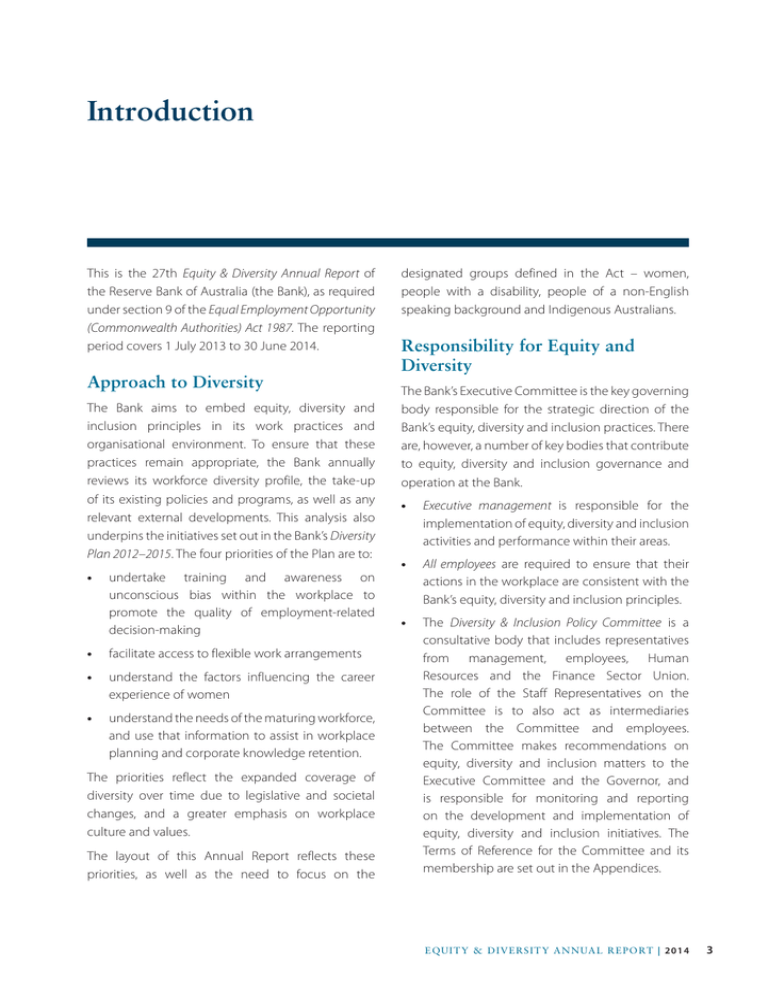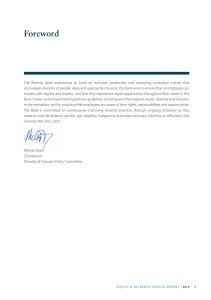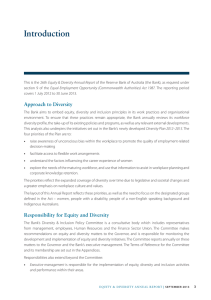Introduction
advertisement

Introduction This is the 27th Equity & Diversity Annual Report of the Reserve Bank of Australia (the Bank), as required under section 9 of the Equal Employment Opportunity (Commonwealth Authorities) Act 1987. The reporting period covers 1 July 2013 to 30 June 2014. Approach to Diversity The Bank aims to embed equity, diversity and inclusion principles in its work practices and organisational environment. To ensure that these practices remain appropriate, the Bank annually reviews its workforce diversity profile, the take-up of its existing policies and programs, as well as any relevant external developments. This analysis also underpins the initiatives set out in the Bank’s Diversity Plan 2012–2015. The four priorities of the Plan are to: •• undertake training and awareness on unconscious bias within the workplace to promote the quality of employment-related decision-making •• facilitate access to flexible work arrangements •• understand the factors influencing the career experience of women •• understand the needs of the maturing workforce, and use that information to assist in workplace planning and corporate knowledge retention. The priorities reflect the expanded coverage of diversity over time due to legislative and societal changes, and a greater emphasis on workplace culture and values. The layout of this Annual Report reflects these priorities, as well as the need to focus on the designated groups defined in the Act – women, people with a disability, people of a non-English speaking background and Indigenous Australians. Responsibility for Equity and Diversity The Bank’s Executive Committee is the key governing body responsible for the strategic direction of the Bank’s equity, diversity and inclusion practices. There are, however, a number of key bodies that contribute to equity, diversity and inclusion governance and operation at the Bank. •• Executive management is responsible for the implementation of equity, diversity and inclusion activities and performance within their areas. •• All employees are required to ensure that their actions in the workplace are consistent with the Bank’s equity, diversity and inclusion principles. •• The Diversity & Inclusion Policy Committee is a consultative body that includes representatives from management, employees, Human Resources and the Finance Sector Union. The role of the Staff Representatives on the Committee is to also act as intermediaries between the Committee and employees. The Committee makes recommendations on equity, diversity and inclusion matters to the Executive Committee and the Governor, and is responsible for monitoring and reporting on the development and implementation of equity, diversity and inclusion initiatives. The Terms of Reference for the Committee and its membership are set out in the Appendices. e qu ity & dive rsity an n ual r e p o rt | 2 0 1 4 3 •• Diversity Contact Managers are responsible for monitoring the implementation of diversity initiatives in their respective departments (which is reported on to the Diversity and Inclusion Policy Committee), and for acting as intermediaries between the Committee and employees. •• The Accessibility Consultative Group makes practical suggestions for improvements to the accessibility of computing systems, information and building facilities. Representatives of this body are drawn from relevant departments (namely Information Technology, Information Department, Facilities Management Department and Human Resources) and other interested employees. •• Human Resources provides specialist advice as well as support to assist in the development and implementation of the Bank’s Diversity & Inclusion Program. Policy initiatives During the year, the Bank introduced a new Workplace Behaviour Policy which specifically recognises the Bank’s commitment to providing a workplace where employees are free from all forms of unlawful discrimination, harassment and bullying. The Policy also highlights the Bank’s commitment to principles of equal employment opportunity. Promoting Diversity and Inclusion Training and awareness For equity, diversity and inclusion principles to be integrated into all work practices, employees must be well informed about the Bank’s diversity-related policies and relevant legislation. The Bank strives to achieve this through its policy framework, training and awareness-raising initiatives. The Bank actively promotes diversity through its leadership development programs to executive and senior management, including ethical decisionmaking workshops and unconscious bias and inclusive leadership programs. These programs support expected workplace behaviours and assist managers in embedding the Bank’s values. The Bank launched a multi-year People and Culture Strategy following the unconscious bias and inclusive leadership program in 2013. The Strategy recognises executive management’s commitment to ensuring that the Bank provides a productive, inclusive and rewarding workplace. The importance of fostering an inclusive and flexible work environment is one of the four focus points of the Strategy, along with employee engagement, talent management and leadership development. The Bank keeps up to date on external equity, diversity and inclusion matters through its diversity memberships and accreditations to ensure its Diversity & Inclusion Program remains current. During the reporting period, the Bank participated in 4 various programs of the Diversity Council Australia, an independent, not-for-profit diversity adviser to businesses in Australia. The Bank also renewed its membership with the Australian Network on Disability (a not-for-profit organisation that aims to advance the inclusion of people with a disability in all aspects of employment) and the NSW Equal Employment Opportunity Practitioners’ Association. The Bank was also re-accredited as a Breastfeeding Friendly Workplace by the Australian Breastfeeding Association. R es erv e Ba nk of Aus t r a l i a During the reporting period, the Bank ensured that all employees are appropriately trained in workplace responsibilities related to equity, diversity and conduct. All employees completed training on the Code of Conduct and an online module on Workplace Behaviours, which reviews the Bank’s values, expected workplace behaviours, roles and responsibilities, anti-discrimination legislation and the Bank’s Diversity & Inclusion Program. The Bank also raises awareness about equity, diversity and inclusion matters as part of the induction process for all new employees. This focuses on the Bank’s Code of Conduct, workplace behaviour and ethical decision-making training. The Bank’s Grievance Contact Officer network provides information and advice to employees on a confidential basis to assist them with work-related grievances, by considering issues, desired outcomes and available resolution options. The role of the Grievance Contact Officer network was promoted to all staff through the intranet and training sessions. Grievance Contact Officers received training in handling grievances – helping to bring them up to date with recent legislative changes. As part of the 2013 RBA Employee Engagement Survey, the Bank collected data related to employees’ workplace experiences and attitudes (see page 6). Employees provided positive feedback about their diversity-related workplace experiences, which were more favourable than that of similar external benchmark organisations. Information on diversity is made available within the Bank in a number of ways. These include face-to-face awareness sessions on diversity-related issues, topical articles in the monthly employee magazine, Currency, and the advertising of events in the weekly communications publication, This Week. Policy changes are communicated to staff as they occur via the newsletter, Staff Matters. Diversity-related policies, programs and resources, such as the Bank’s Diversity Plan, the Equity & Diversity Annual Report, recordings of training workshops and guides for employees on diversity matters such as accessibility are available on the Bank’s intranet page. At the end of June 2014, the Reserve Bank employed 1 200 staff,1 an increase of 8 per cent from a year earlier. This increase, in part, reflects the recruitment of information technology professionals to support the Bank’s technology projects. Most diversity groups have maintained a fairly constant share of employment at the Bank over the past decade (Graph 1). The exception to this has been an increase in employees from a non-English speaking background and a slight decrease in employees with a disability. Further information is provided in the next section of this Report. The Reserve Bank’s Diversity Profile Graph 1 Diversity Profile at the RBA Data Collection Equity and diversity information is sought from employees when they commence employment at the Bank and as part of a periodic profile update. It is provided on a voluntary basis, and includes information on disability, ethnic origin and proficiency in languages other than English. The Bank’s equity and diversity statistics are based primarily on these data, which represent 91 per cent of employees who have disclosed their diversity details. For potential employees of the Bank, the job application form contains an equity and diversity questionnaire, which provides the Bank with a better understanding of the applicants from a diversity perspective and facilitates any reasonable adjustments that might be required, both during the recruitment process and subsequent employment. Per cent of total staff, as at June % % 60 60 Men 50 50 Women 40 40 30 30 Staff born overseas from a NESB* 20 10 0 20 Staff with parent(s) from a NESB* Staff with a disability Indigenous Australians 2004 2006 2008 10 0 2010 2012 2014 * Non-English speaking background Source: RBA 1 Includes locally employed staff in overseas offices. e qu ity & dive rsity an n ual r e p o rt | 2 0 1 4 5 Employee Engagement Survey During the reporting period, the Bank’s Employee Engagement Survey indicated that 80 per cent of employees hold favorable views towards diversity at the Bank, which is above external benchmarks. The survey highlighted that diversity is one the key strengths of the Bank’s culture, in particular management’s support of diversity, the level of respect experienced by employees, along with employees’ ability to balance work and personal responsibilities. In addition, the vast majority of employees reported that the Bank provides a work environment free of discrimination and harassment. 6 R es erv e Ba nk of Aus t r a l i a


